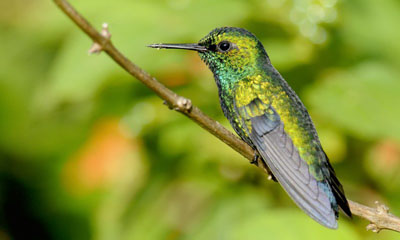
Blue-tailed Emerald
Chlorostilbon mellisugus
Apodiforme Order – Trochilidae Family
BIOMETRICS:
L: M: 7,5-8,5 cm – F: 6,5-7,5 cm
Poids 2,6 à 3,5 gr
DESCRIPTION:
Found in tropical and subtropical South America, the Blue-tailed Emerald is a small hummingbird common in gardens near habitations.
Adult male has glossy bronze-green upperparts. Flight feathers are brownish-grey. Tail feathers are deep blue. The tail is more or less forked, according to the races.
The underparts are glossy emerald-green, with more iridescent breast. Underwing and undertail are dusky.
The head is glossy bronze-green on forehead, crown and face. Chin and throat are emerald-green.
The thin, straight bill is black and about 13 mm length. Eyes are dark brown. Legs and feet are dark grey.
Fr: Emeraude orvert
All: Smaragdkolibri
Esp: Esmeralda de Cola Azul
Ital: Colibrì smeraldo codablu
Nd: Blauwstaart-smaragdkolibrie
Port: Esmeralda-de-cauda-azul
Photographs by Patrick Ingremeau
TAMANDUA
Text by Nicole Bouglouan
Sources:
HANDBOOK OF THE BIRDS OF THE WORLD Vol 5 by Josep del Hoyo-Andrew Elliott-Jordi Sargatal - Lynx Edicions - ISBN: 8487334253
A GUIDE TO THE BIRDS OF COLOMBIA by Steven L. Hilty and William L. Brown
Princeton University Press – ISBN 069108372X
Wikipedia (Wikipedia, The Free Encyclopedia)
Discovering the birds of Trinidad and Tobago (Brian Ramsey)

Female has metallic green upperparts and pale grey underparts. Tail is dark blue, narrowly tipped pale greyish on outer rectrices.
The head has bronze-green forehead and crown. We can see a pale whitish-grey spot behind the eye, and a blackish band from lores, below the eye to ear-coverts. Chin is pale greyish.
Immature is similar to adult female. It reaches its sexual maturity in the second year.
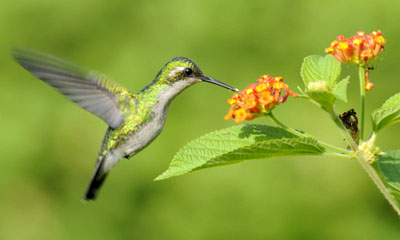
The Blue-tailed Emerald has 17 subspecies in the range. They differ in colour with plumage more or less bronze-green to golden-green on the upperparts, and bronze-green to emerald-green on the underparts.
The fork of the tail extends more or less according to the race. The main differences are bill colour, tail length, fork depth and body colour.
VOICE: SOUNDS BY XENO-CANTO
Blue-tailed Emerald utters a slightly metallic “tsip” as weak call. The song is a short, melodious twitter.
HABITAT:
Blue-tailed Emerald lives from tropical to temperate areas, often from 1000 to 2600 metres of elevation. It can be found at sea-level or up to 3000 metres, according to the range.
It frequents savannahs, shrubby and semi-open areas with trees, cultivated areas, gardens, fields and deciduous woodland edges.
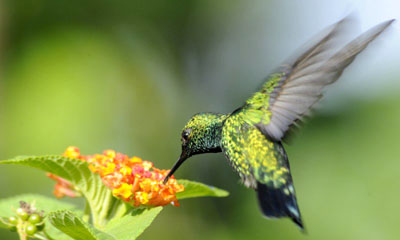
RANGE:
Blue-tailed Emerald is found in tropical and subtropical South America, from Colombia to the Guianas and Trinidad, and south to northern Bolivia and central Brazil.
It also occurs in Central America, from Mexico to Panama.
BEHAVIOUR:
Blue-tailed Emerald feeds mainly on nectar from flowers, at low to moderate height. It prefers short tubed flowers with its short bill. It usually feeds alone in areas with scattered flowers where larger hummingbirds do not occur.
Due to its short bill, the Blue-tailed Emerald sometimes performs “nectar-robbing” behaviour. It pierces holes at the base of the petals to obtain the nectar, mainly in flowers with long corollas.
It also hawks flying insects in the air.
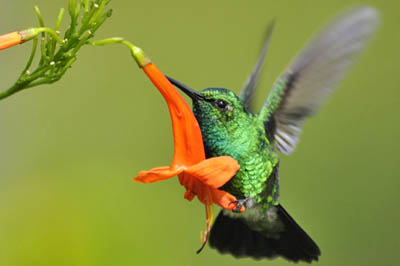
Blue-tailed Emerald is sedentary in its range. It performs some post-breeding altitudinal movements. It defends strongly its territory against intruders, performing diving flights, intending to stab each other with the bill.
FLIGHT:
The blue-tailed Emerald performs straight and fast flight.
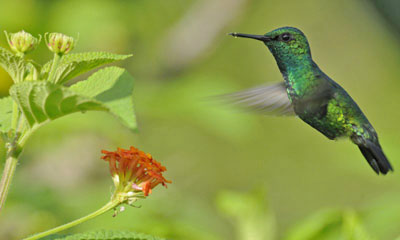
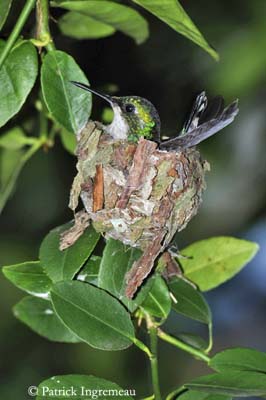
REPRODUCTION:
Breeding season varies according to the range.
The Blue-tailed Emerald female selects the nest-site close to her feeding area. The nest is usually located in dense secondary-scrub or woodland, low into vegetation, at about 80 cm above the ground.
The tiny cup-shaped nest (3 cm of diameter), is made with coloured plant down, fastened with spider webs. The interior is lined with pale coloured plant down, and this lining also covers the rim. Some fine bark fragments are added on the exterior of the nest, as camouflage.
The nest is often built under overhanging vegetation, protecting against sun and rain.
Female usually lays 2 white eggs. Incubation lasts about 2 weeks, by female alone. At hatching, the chicks have dark greyish-brown skin above, and rufous below. On the back, we can see two lines of dusky down.
The chicks are fed by regurgitation of mixture made with nectar and arthropods.
The young fledge 23 to 26 days after hatching.
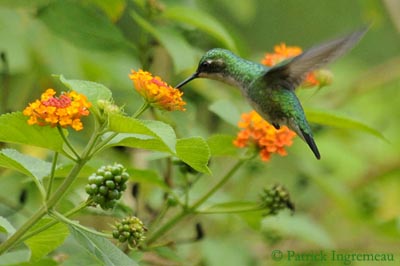
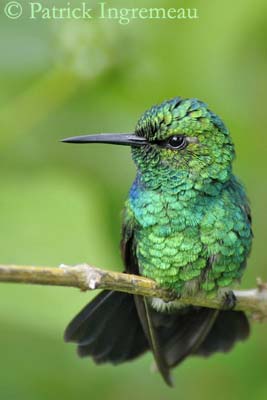
DIET:
Blue-tailed Emerald feeds mainly on nectar from flowers (Hibiscus and Cannaceae), and it also hawks flying insects.
PROTECTION / THREATS / STATUS:
Blue-tailed Emerald is usually common throughout its wide range, especially in Honduras.
This species is not threatened at this moment.